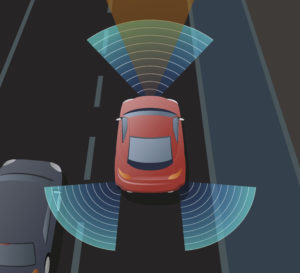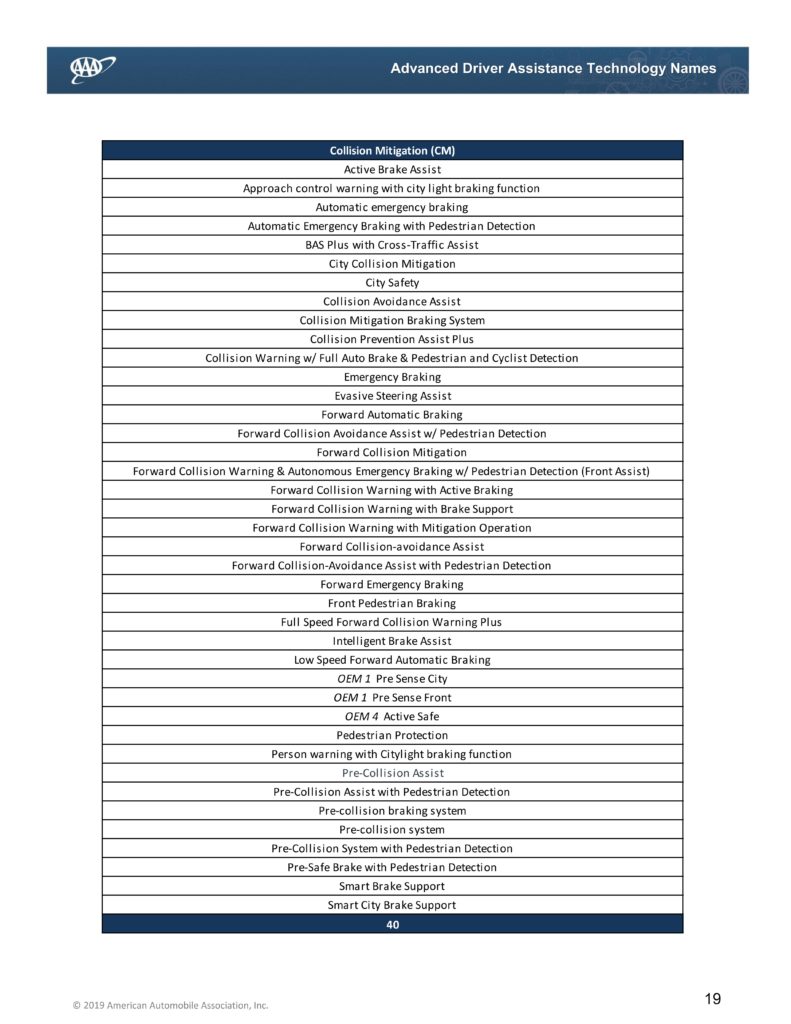
SAE International endorses generic ADAS terminology recommendations
By onAnnouncements | Associations | Education | Market Trends | Repair Operations | Technology
SAE International, the standards organization for vehicle engineers, announced Tuesday it officially endorsed the series of generic ADAS terms it had worked on alongside J.D. Power, Consumer Reports, AAA and the National Safety Council.
“The consumer-facing document provides a framework for the development of industry-wide safety standards,” SAE wrote in a news release Tuesday.
SAE said it would use the input from stakeholders working on the “Clearing the Confusion” recommendations to revise its J-3063 standard, “a more detailed document for use by engineers.”
“AAA, Consumer Reports, J.D. Power and the National Safety Council commends SAE International in its endorsement of common naming of advanced driver assistance systems as well as its consideration to revise the SAE J3063 Standard to directly support the effort of clearing the confusion for consumers regarding new vehicle technology,” AAA wrote in a news release Tuesday.
The effort could make life easier for collision repairers as well as the consumers the four entities hope to assist.
According to a joint November 2019 news release from AAA, Consumer Reports, J.D. Power and the NSC announcing an earlier draft of the terms, 93 percent of new vehicles offer at least one piece of ADAS. However, consumers and body shops might misunderstand what the technology does given the number of different names on the market.
AAA in January 2019 said a study of 34 vehicle brands found autobraking had the most unique names on the market of any ADAS feature, at 40. Adaptive cruise control and the ability to have a 360-degree view around the vehicle tied for second at 20. Lane-keeping and blind-spot warnings placed third at 19 different OEM names for each.
The new document offers 20 terms associated with specific ADAS functions.
For example:
“Forward Collision Warning” only “Detects a potential collision with a vehicle ahead and alerts the driver. Some systems also provide alerts for pedestrians or other objects.”
But an “Automatic Emergency Braking” system “Detects potential collisions with a vehicle ahead, provides forward collision warning, and automatically brakes to avoid a collision or lessen the severity of impact. Some systems also detect pedestrians or other objects.”
SAE on Tuesday and the quartet in November 2019 said their plan wasn’t intended to block OEMs from branding ADAS with catchy names.
“It is believed that, by adopting common terminology across systems, consumers will have a better understanding that this technology is intended to assist and not replace an engaged driver,” AAA wrote in the November 2019 news release. “These terms are not meant to replace automotive manufacturers’ proprietary system or package names; rather, they are meant to achieve clearer and consistent information on window stickers, owner’s manuals and other marketing materials on generic system components.”
“These recommendations are not meant to replace automaker proprietary system or package names, but rather help identify key functions within those packages and provide clarity to consumers,” SAE technical program manager Keith Wilson said in a statement Tuesday. “As safety technologies advance and as new systems are developed, we plan to work with stakeholders to refine the naming outline to keep the public and industry informed.”
Adding that standardized terminology in repair manuals as well as owner-facing documents could be particularly helpful in researching OEM procedures for a formal collision repair plan. It’s inefficient if a shop has to look up what the heck an OEM calls a particular system to run a search for precautions and calibration instructions in the repair procedures. It’d be a lot easier on an estimator or tech to memorize 20 terms in five categories once rather than keep track of the scores of names AAA uncovered back in January 2019.
Consumers who better understand their vehicle technology also might be less inclined to bother repairers with unjustified “bring-backs.” (For example, a consumer complaining that a forward collision warning system didn’t stop the car automatically following a repair.) Or worse, a lawsuit.
Here’s the terms and definitions from “Clearing the Confusion” initiative as of March 5. “The list will be continually refined as we work with other stakeholders and as new systems are developed,” the document warns. (Emphasis original.)
Collision Warning
Blind Spot Warning: Detects vehicles in the blind spot while driving and notifies the driver to their presence. Some systems provide an additional warning if the driver activates the turn signal.
Forward Collision Warning: Detects a potential collision with a vehicle ahead and alerts the driver. Some systems also provide alerts for pedestrians or other objects.
Lane Departure Warning: Monitors vehicle’s position within the driving lane and alerts driver as the vehicle approaches or crosses lane markers.
Parking Collision Warning: Detects objects close to the vehicle during parking maneuvers and notifies the driver.
Rear Cross Traffic Warning: Detects vehicles approaching from the side at the rear of the vehicle while in reverse gear and alerts the driver. Some systems also warn for pedestrians or other objects.
Collision Intervention
Automatic Emergency Braking: Detects potential collisions with a vehicle ahead, provides forward collision warning, and automatically brakes to avoid a collision or lessen the severity of impact. Some systems also detect pedestrians or other objects.
Automatic Emergency Steering: Detects potential collisions with a vehicle ahead and automatically steers to avoid or lessen the severity of impact. Some systems also detect pedestrians or other objects.
Reverse Automatic Emergency Braking: Detects potential collisions while in reverse gear and automatically brakes to avoid or lessen the severity of impact. Some systems also detect pedestrians or other objects.
Driving Control Assistance
Adaptive Cruise Control: Cruise control that also assists with acceleration and/or braking to maintain a driverselected gap to the vehicle in front. Some systems can come to a stop and continue while others cannot.
Lane Keeping Assistance: Provides steering support to assist the driver in preventing the vehicle from departing the lane. Some systems also assist to keep the vehicle centered within the lane.
Active Driving Assistance: Provides steering and brake/acceleration support to the driver at the same time. The driver must constantly supervise this support feature and maintain responsibility for driving.
Parking Assistance
Backup Camera: Displays the area behind the vehicle when in reverse gear.
Surround View Camera: Displays the immediate surroundings of some or all sides of the vehicle while stopped or during low speed maneuvers.
Active Parking Assistance: Assists with steering and potentially other functions during parking maneuvers. Driver may be required to accelerate, brake, and/or select gear position. Some systems are capable of parallel and/or perpendicular parking. The driver must constantly supervise this support feature and maintain responsibility for parking.
Remote Parking Assistance: Without the driver being physically present inside the vehicle, provides steering, braking, accelerating and/or gear selection while moving a vehicle into or out of a parking space. The driver must constantly supervise this support feature and maintain responsibility for parking.
Trailer Assistance: Assists the driver with visual guidance while backing towards a trailer or during backing maneuvers with a trailer attached. Some systems may provide additional images while driving or backing with a trailer. Some systems may provide steering assistance during backing maneuvers.
Other Driver Assistance Systems
Automatic High Beams: Switches between high and low beam headlamps automatically based on lighting and traffic.
Driver Monitoring: Observes driver actions to estimate if they are not engaged in the task of driving. Some systems may monitor eye movement and/or head position.
Head-Up Display: Projects information relevant to driving into the driver’s forward line of sight.
Night Vision: Improves forward visibility at night by projecting enhanced images on instrument cluster or head-up display.
The “Clearing the Confusion” document notes that “Remote Parking Assistance” and “Active Driving Assistance” are considered Level 2 autonomy under the separate SAE J-3016 standard.
The J-3063 standard SAE is revising currently declares, “Included are warning and momentary intervention systems, which do not automate any part of the dynamic driving task on a sustained basis like those defined in SAE J3016 Automated Driving Systems.”
More information:
SAE, May 12, 2020
AAA, Consumer Reports, J.D. Power, National Safety Council, SAE International, March 5, 2020
J-3063 “Active Safety Systems Terms & Definitions”
Images:
Commonly understood terms for various advanced driver assistance systems features might help repairers and consumers better understand their function. (chombosan/iStock)
AAA’s study of 34 vehicle brands found autobraking had the most unique names of any ADAS feature, at 40. (Provided by AAA)

